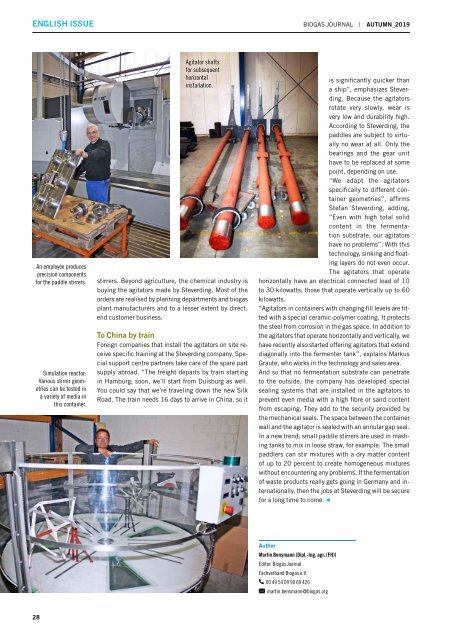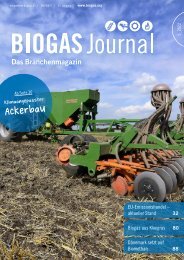Autumn 2019 EN
You also want an ePaper? Increase the reach of your titles
YUMPU automatically turns print PDFs into web optimized ePapers that Google loves.
English Issue<br />
Biogas Journal<br />
| <strong>Autumn</strong>_<strong>2019</strong><br />
An employee produces<br />
precision components<br />
for the paddle stirrers.<br />
Simulation reactor:<br />
Various stirrer geometries<br />
can be tested in<br />
a variety of media in<br />
this container.<br />
Agitator shafts<br />
for subsequent<br />
horizontal<br />
installation.<br />
stirrers. Beyond agriculture, the chemical industry is<br />
buying the agitators made by Steverding. Most of the<br />
orders are realised by planning departments and biogas<br />
plant manufacturers and to a lesser extent by direct,<br />
end customer business.<br />
To China by train<br />
Foreign companies that install the agitators on site receive<br />
specific training at the Steverding company. Special<br />
support centre partners take care of the spare part<br />
supply abroad. “The freight departs by train starting<br />
in Hamburg; soon, we’ll start from Duisburg as well.<br />
You could say that we’re traveling down the new Silk<br />
Road. The train needs 16 days to arrive in China, so it<br />
is significantly quicker than<br />
a ship”, emphasizes Steverding.<br />
Because the agitators<br />
rotate very slowly, wear is<br />
very low and durability high.<br />
According to Steverding, the<br />
paddles are subject to virtually<br />
no wear at all. Only the<br />
bearings and the gear unit<br />
have to be replaced at some<br />
point, depending on use.<br />
“We adapt the agitators<br />
specifically to different container<br />
geometries”, affirms<br />
Stefan Steverding, adding,<br />
“Even with high total solid<br />
content in the fermentation<br />
substrate, our agitators<br />
have no problems”. With this<br />
technology, sinking and floating<br />
layers do not even occur.<br />
The agitators that operate<br />
horizontally have an electrical connected load of 10<br />
to 30 kilowatts; those that operate vertically up to 60<br />
kilowatts.<br />
“Agitators in containers with changing fill levels are fitted<br />
with a special ceramic-polymer coating. It protects<br />
the steel from corrosion in the gas space. In addition to<br />
the agitators that operate horizontally and vertically, we<br />
have recently also started offering agitators that extend<br />
diagonally into the fermenter tank”, explains Markus<br />
Graute, who works in the technology and sales area.<br />
And so that no fermentation substrate can penetrate<br />
to the outside, the company has developed special<br />
sealing systems that are installed in the agitators to<br />
prevent even media with a high fibre or sand content<br />
from escaping. They add to the security provided by<br />
the mechanical seals. The space between the container<br />
wall and the agitator is sealed with an annular gap seal.<br />
In a new trend, small paddle stirrers are used in mashing<br />
tanks to mix in loose straw, for example. The small<br />
paddlers can stir mixtures with a dry matter content<br />
of up to 20 percent to create homogeneous mixtures<br />
without encountering any problems. If the fermentation<br />
of waste products really gets going in Germany and internationally,<br />
then the jobs at Steverding will be secure<br />
for a long time to come.<br />
Author<br />
Martin Bensmann (Dipl.-Ing. agr. (FH))<br />
Editor, Biogas Journal<br />
Fachverband Biogas e.V.<br />
00 49 54 09 90 69 426<br />
martin.bensmann@biogas.org<br />
28


















